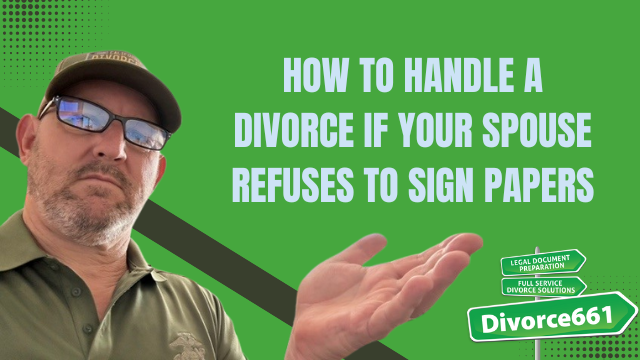How to Handle a Divorce If Your Spouse Refuses to Sign Papers
Facing a divorce when your spouse refuses to sign the papers can feel daunting. Fortunately, California’s no-fault divorce laws empower you to move forward without needing their consent. Let’s dive into how you can navigate this situation effectively, ensuring you understand your rights and the legal processes involved.
Understanding California’s No-Fault Divorce System
California operates under a no-fault divorce system, which means that neither spouse needs to prove wrongdoing to obtain a divorce. This is crucial because it simplifies the process significantly. You only need to cite “irreconcilable differences” to initiate divorce proceedings. This framework means that even if your spouse refuses to cooperate, you still have the legal ability to proceed.
The Process of Filing for Divorce
Initiating a divorce involves a few key steps. First, you need to file a petition for dissolution of marriage with the family court. This document formally starts the legal process and only requires your signature. Once the petition is filed, you must serve your spouse with the divorce papers to notify them of the proceedings.
Serving Your Spouse
Serving divorce papers is a legal requirement. This ensures that your spouse is officially informed about the divorce and has the opportunity to respond. If they refuse to accept the papers, don’t worry; there are several methods available:
- Personal Service: A process server or sheriff can hand-deliver the papers directly to your spouse.
- Substituted Service: If your spouse is avoiding you, you can leave the papers with a responsible adult at their home or workplace, and mail a copy to them.
- Service by Publication: If all else fails, you can publish a notice in a local newspaper after obtaining court approval.
What Happens If Your Spouse Doesn’t Respond?
Once served, your spouse has 30 days to respond. If they ignore the petition, you can request a default judgment. A default judgment allows the court to proceed with the divorce without their input, meaning decisions regarding asset division, child custody, and support can be made based on the information you provide.
Understanding Default Judgments
A default divorce is a legal way to finalize your divorce when one party refuses to participate. Here’s how it works:
- If your spouse does not respond within 30 days, you can file a Request to Enter Default.
- The court will review your petition and can grant the divorce based on your requests.
- Typically, a hearing will be scheduled where you present your case, and the judge will finalize the divorce.
Real-Life Example
Consider a real case where a client faced a similar situation. Their spouse ignored every document sent. Despite this, we served the papers correctly, waited the necessary 30 days, and filed for a full default judgment. The court approved it, and the client was successfully divorced without any signature from the other party. This illustrates how the system is designed to work even without cooperation from one spouse.
Why Choose Divorce661?
At Divorce661, we specialize in ensuring that legal service is handled correctly. We prepare and file the full default judgment package, guiding you through each step of the process. With our flat-fee pricing, there are no hidden surprises, allowing you to focus on moving forward with your life.
Steps to Take When Facing an Uncooperative Spouse
Dealing with an uncooperative spouse can be frustrating. Here are some actionable steps to consider:
- Communicate: If possible, try discussing the reasons behind their refusal. Sometimes, a simple conversation can clear up misunderstandings.
- Seek Legal Help: Engaging a family law attorney can help navigate the complexities of your case.
- File for Divorce: Even if your spouse is uncooperative, you can still file for divorce and serve them legally.
Legal Rights and Responsibilities
It’s important to understand your legal rights during this process. In California, you do not need your spouse’s signature to obtain a divorce. If they fail to respond to the divorce papers, they effectively forfeit their right to contest the terms of the divorce. This means that you can proceed with asset division, child custody arrangements, and support without their input.
Common Myths About Divorce
There are many misconceptions surrounding divorce, especially when one spouse refuses to sign the papers. Here are a few myths debunked:
- Myth: A spouse’s refusal to sign stops the divorce process.
- Fact: California law allows one spouse to proceed with divorce regardless of the other’s consent.
- Myth: You must have both signatures to finalize a divorce.
- Fact: You can obtain a divorce without your spouse’s signature if you follow the proper legal steps.
Conclusion
Divorce can be challenging, especially when faced with an uncooperative spouse. However, understanding California’s no-fault divorce laws empowers you to take control of the situation. By following the necessary legal steps, you can successfully navigate this process and move forward with your life.
If you find yourself in this situation, reach out to Divorce661 for a free consultation. We’re here to help you move forward, whether your spouse cooperates or not. Take the first step towards your new beginning today!

